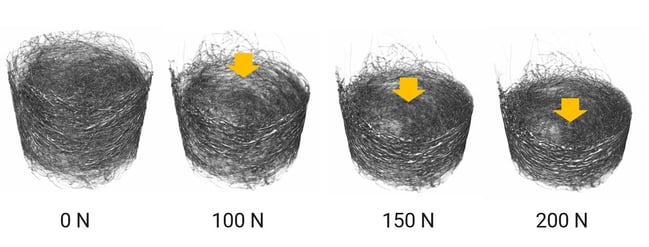Application Note RACCT9036
About the sample: Steel wool
Steel wool can be used to reinforce cement (Amer et al., (2021) Materials, 14(5), 1094). Properties of the steel wool, such as fiber orientations, lengths, and packing density, can affect the strength of the cement. These parameters, especially the fiber orientation, can also be affected by the mixing process or stress added to the fibers. X-ray micro-CT (computed tomography) can image the steel wool fibers in cement or under stress to study these characteristics.
Analysis procedure
- In this example, steel wool under varying compressive stress was scanned in-situ using a high-speed-CT scanner, CT Lab GX.
- The CT images of the steel wool under varying compressive stress up to 200 N were compared.
- The change in the steel fiber orientation was analyzed.
1. CT scan
The steel wool was scanned to produce the 3D grayscale CT images. The compression stress up to 200 N was added to observe the change in the steel fiber orientation.

2. Change in overall shape under stress
3D rendering of the steel wool under 0, 100, 150, and 200 N are shown in the figure. The compression stress was added from the top to press down the steel wool. You can see that the steel wool shrinks mostly in the height direction.

3. Steel fiber orientation analysis
The individual fibers were segmented, and their orientations were analyzed. Red, blue, and green indicate vertically, at a 45-degree angle, and horizontally oriented fibers, respectively. When there was no stress, many vertical (red) fibers were seen on the right side. As the compressive stress increased, these vertical (red) fibers turned blue and green, indicating that the fiber orientation changed to accommodate the compressive stress.


